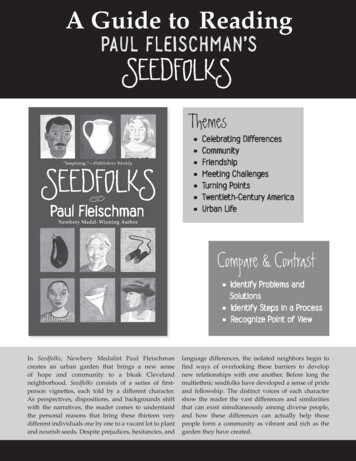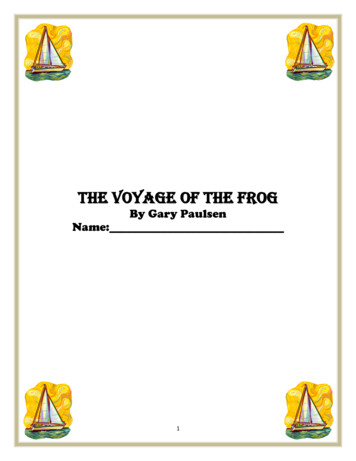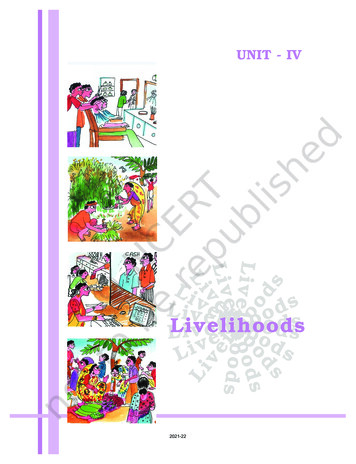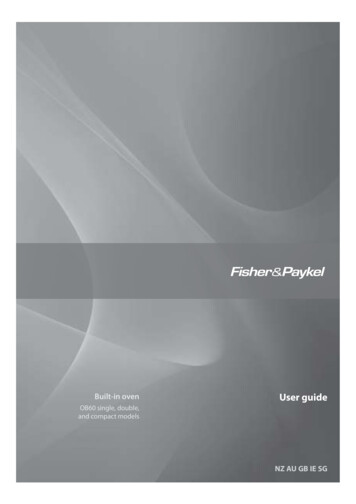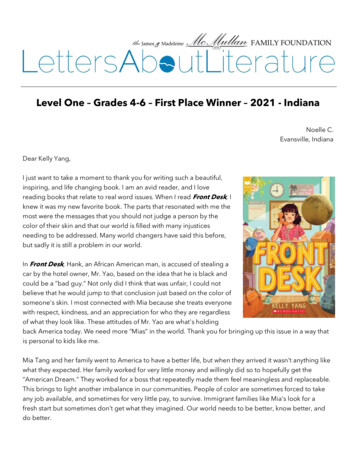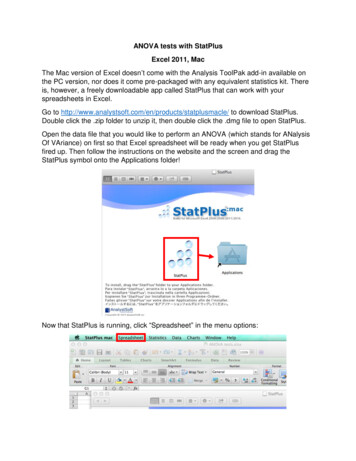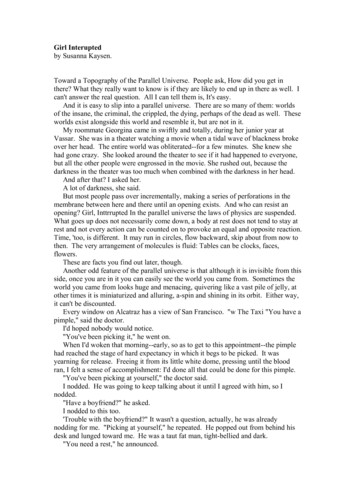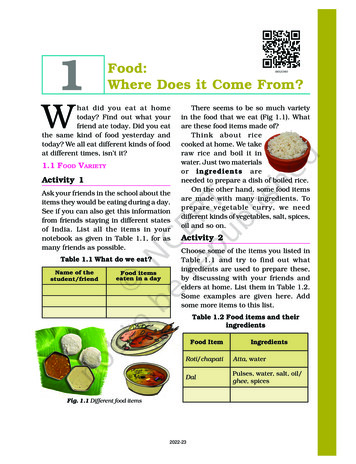
Transcription
1Food:Where Does it Come From?What did you eat at hometoday? Find out what yourfriend ate today. Did you eatthe same kind of food yesterday andtoday? We all eat different kinds of foodat different times, isn’t it?1.1 FOOD VARIETYActivity 1Ask your friends in the school about theitems they would be eating during a day.See if you can also get this informationfrom friends staying in different statesof India. List all the items in yournotebook as given in Table 1.1, for asmany friends as possible.Table 1.1 What do we eat?Name of thestudent/friendFood itemseaten in a dayThere seems to be so much varietyin the food that we eat (Fig 1.1). Whatare these food items made of?Think about ricecooked at home. We takeraw rice and boil it inwater. Just two materialsor ingredients areneeded to prepare a dish of boiled rice.On the other hand, some food itemsare made with many ingredients. Toprepare vegetable curry, we needdifferent kinds of vegetables, salt, spices,oil and so on.Activity 2Choose some of the items you listed inTable 1.1 and try to find out whatingredients are used to prepare these,by discussing with your friends andelders at home. List them in Table 1.2.Some examples are given here. Addsome more items to this list.Table 1.2 Food items and theiringredientsFood ItemIngredientsRoti/chapatiAtta, waterDalPulses, water, salt, oil/ghee, spicesFig. 1.1 Different food items2022-23
What do we find? Do we find some ingredients commonfor different food items? Discuss in class.So, where do these ingredients come from?1.2 FOOD MATERIALSANDSOURCESIt may be easy for us to guess the sources of some of theingredients that we listed in Table 1.2. Fruits andvegetables, for instance (Fig. 1.2a). Where do they comefrom? Plants, of course! What are the sources of rice orwheat? You may have seen paddy or wheat fields with rowsand rows of plants, which give us these grains (Fig. 1.3).And then, there are food items like milk, eggs and meat,which come from animals (Fig. 1.2b).Activity 3(a) Plant sourcesFig. 1.2 Sources offood ingredientsLet us take the food items listed earlierand try to find out where they come from— the ingredients and their sources.Some examples are shown in Table 1.3.Fill in the blanks in Table 1.3 and addmore examples to this list.(b) Animal sourcesTable 1.3 Ingredients used toprepare food items andtheir sourcesFood Item IngredientsIdliRiceSourcesPlantUrad gheePlants/AnimalsWaterKheer(b)Fig. 1.3 Source of food grains(a) Paddy field (b) Wheat grains transportedMilkAnimalRicePlantSugar2SCIENCE2022-23
What do we conclude from Activity3? Plants are the sources of foodingredients like grains, cereals,vegetables and fruits. Animals provideus with milk, meat products and eggs.Cows, goats and buffaloes are somecommon animals which give us milk.Milk and milk products like butter,cream, cheese and curd are used all overthe world. Can you name some otheranimals which give us milk?FlowerFruitStemLeafNodeInternode{Bud1.3 PLANT PARTS AND ANIMALPRODUCTS AS FOODPlants are one source of our food. Whichparts of a plant?We eat many leafy vegetables. We eatfruits of some plants. Sometimes roots,sometimes stems and even flowers(Fig 1.4). Have you ever eaten pumpkinPaheli wants to know if any of ourfood comes from sources otherthan plants and animals.ShootsystemPrimaryrootRootSecondary systemrootFig. 1.4 Different edible parts of plantsflowers dipped in rice paste and fried?Try it!Some plants have two or more edible(eatable) parts. Seeds of mustard plantsgive us oil and the leaves areused as a vegetable. Can you think ofthe different parts of a banana plant thatare used as food? Think of moreexamples where two or more parts of asingle plant are used as food.Table 1.4 Plant parts as foodFood item with plantas the major source1. Brinjal curryIngredients/sourcePlant part which givesus the ingredientBrinjalFruitChilli as spice (any other)FruitOil from groundnut, mustard,soybean, any other plantSeed2.3.FOOD: WHERE DOES IT COME FROM?32022-23
Do not try to taste unknown plantsaround you to see if they are edible!Some plants could be poisonous.Activity 4From all the food items you have listedin Table 1.3, choose those items whoseingredients are obtained from plants.Which part of a plant? Identify theseand list the food items and plant partsas shown in Table 1.4.Fig. 1.6 Chana (gram) and its sproutscovered with a wet cloth. The next day,see if the seeds have sprouted.After washing these sprouted seeds,you can eat them. They can also beboiled. Add some spices and get a tastysnack to eat.Do you know where honey comesfrom, or how it is produced? Have youseen a beehive where so many bees keepbuzzing about? Bees collect nectar(sweet juices) from flowers, convert itActivity 5Take some dry seeds of moong or chana.Put a small quantity of seeds in acontainer filled with water and leave thisaside for a day. Next day, drain the watercompletely and leave the seeds in thevessel. Wrap them with a piece of wetcloth and set aside. The following day,do you observe any changes in the seeds?Fig. 1.7 BeehiveFig. 1.5 Whole moong and its sproutsA small white structure may have grownout of the seeds. If so, the seeds havesprouted (Fig. 1.5 and 1.6). If not, washthe seeds in water, drain the water andleave them aside for another day,into honey and store it in their hive(Fig. 1.7). Flowers and their nectar maybe available only for a part of the year.So, bees store this nectar for their useall through the year. When we find sucha beehive, we collect the food stored bythe bees as honey.1.5 WHATDOANIMALS EAT?Do you have cattle or a pet that you takecare of? A dog, cat, buffalo or a goat?4SCIENCE2022-23
eat is also given. Fill in the blanks inthe table.Activity 7Fig. 1.8 Squirrel eating nutsYou will then surely be aware of the food,the animal eats. What about otheranimals? Have you ever observed whata squirrel (Fig 1.8), pigeon, lizard or asmall insect may be eating as their food?Activity 6Several animals are listed in Table 1.5.For some of them, the type of food theyTable 1.5 Animals and their FoodName of theanimalHave a look again at Table 1.5 and groupthe animals entered here as follows.Place animals which eat only plants orplant products in Group 1. These arecalled herbivores. There are someanimals which eat other animals.Place these in Group 2. These animalsare called carnivores. Do you findsome animals which eat both plantsand animals? Place them in Group 3.These are called omnivores. Preparea table as in Table 1.6 and enterthese separately in the three columns,as shown.Table 1.6Herbivores Carnivores OmnivoresFood theanimal eatsBuf faloGrass, oilcake,hay, grainsCatSmall animals,birds, milkCowLionD ogRatLionT igerSpiderPaheli wants to know where youwould place human beings,while filling Table 1.6.House lizardCowHuman beingsButter flyCrowOthersWe know that there are manyamongst us, who do not get sufficientFOOD: WHERE DOES IT COME FROM?52022-23
food. We need to find ways by whichmore food can be produced in thecountry. That will not be enough; wewill need to find ways to ensure thatthis food is made easily available to eachone of us.IngredientsEdibleNectarSprouted seedsHerbivoreCar nivoreOmnivorenThere is a lot of variation in the food eaten in different regions of India.nThe main sources of our food are plants and animals.nAnimals which eat only plants are called herbivores.nAnimals which eat only animals are called carnivores.nAnimals which eat both plants as well as other animals are calledomnivores.1.Do you find that all living beings need the same kind of food?2.Name five plants and their parts that we eat.3.Match the items given in Column A with that in Column BColumn AColumn BMilk, curd, paneer, ghee,eat other animalsSpinach, cauliflower, carroteat plants and plant productsLions and tigersare vegetablesHerbivor esare all animal products6SCIENCE2022-23
4.Fill up the blanks with the words given:herbivore, plant, milk, sugarcane, carnivore(a) Tiger is a because it eats only meat.(b) Deer eats only plant products and so, is called .(c) Parrot eats only products.(d) The that we drink, which comes from cows, buffaloes andgoats is an animal product.(e) We get sugar from .SUGGESTED PROJECTS AND ACTIVITIES1.You must have seen a garden lizard around your home. Next time whenever you see it, observe carefully and find out what it takes for food. Is thefood different from that of a house lizard?2.Make a list (with pictures, when possible) of food items generally taken bypeople of different regions of India. Place these on a large outline map ofIndia to display in your classroom.3.Find out the names of plants that grow in water and which are eatenas food.4.In Chapter 10, you will find out ways of measuring length of curved lines.In your mathematics classes you will learn to prepare bar graphs. Afteryou learn these, try the following interesting project. Prepare some sproutsof moong as discussed in the chapter. Wash them in water everyday anddrain all the water. Let them grow for a week until the whole of the seedsgrow into young plants. Measure the lengths of the sprouts everyday usinga string. Take care that they do not break. Prepare a bar graph of thenumber of sprouts having lengths in different ranges.THINGS TO THINK ABOUT1.Does everyone around you get enough food to eat? If not, why?2.What are the ways we can think of to avoid wastage of food?FOOD: WHERE DOES IT COME FROM?72022-23
6 SCIENCE n There is a lot of variation in the food eaten in different regions of India. n The main sources of our food are plants and animals. n Animals which eat only plants are called herbivores. n Animals which eat only animals are called carnivores. n Animals which eat both plants as well as other animals are called omnivores. food. We need to find ways by which


